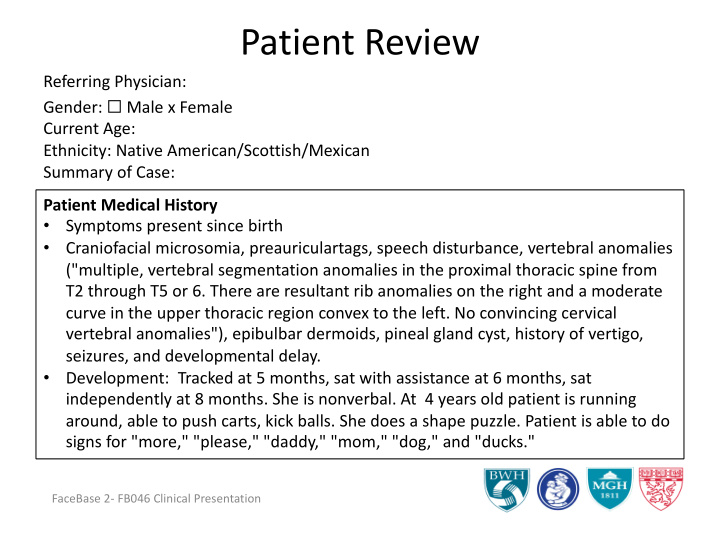



Patient Review Referring Physician: Gender: ☐ Male x Female Current Age: Ethnicity: Native American/Scottish/Mexican Summary of Case: Patient Medical History Symptoms present since birth • Craniofacial microsomia, preauriculartags, speech disturbance, vertebral anomalies • ("multiple, vertebral segmentation anomalies in the proximal thoracic spine from T2 through T5 or 6. There are resultant rib anomalies on the right and a moderate curve in the upper thoracic region convex to the left. No convincing cervical vertebral anomalies"), epibulbar dermoids, pineal gland cyst, history of vertigo, seizures, and developmental delay. Development: Tracked at 5 months, sat with assistance at 6 months, sat • independently at 8 months. She is nonverbal. At 4 years old patient is running around, able to push carts, kick balls. She does a shape puzzle. Patient is able to do signs for "more," "please," "daddy," "mom," "dog," and "ducks." FaceBase 2- FB046 Clinical Presentation
Summary of Systems System Phenotype Eyes/Vision ENT/Mouth Respiratory Cardiovascular Endocrine Gastrointestinal Hemifacial hypoplasia Musculoskeletal Dermatological Absent speech, seizures Neurological Pineal cyst Hematologic/lymphatic Renal Allergic/Immunogenic FaceBase 2- FB046 Clinical Presentation
Other information available Dysmorphic Features: Craniofacial microsomia (Hemifacial hypoplasia), Vertebral anomalies, Preauricular skin tag, Epibulbar dermoids, Hypoplasia of the cerebral white matter, Simplified gyral pattern Previous Genetic Testing: Karyotype and array CGH: Negative. Previous Studies: 3/2012 MRI Brain: 1.Markedly diminished white matter volume associated with abnormal gyration pattern characterized by small irregular gyri in the frontal lobes and simplified gyral pattern in the remaining cerebral cortex. 2. Commissural hypogenesis characterized by absent inferior callosal genu and rostrum, and diminutive anterior commissure. 3. Multiple posterior fossa abnormalities including anterior midline pontomedullary cleft, dysmorphic midbrain, and small pons. The cerebellar vermis is small but the hemispheres appear normal. FaceBase 2- FB046 Clinical Presentation
Family Medical History Family history is significant in that her half-sister, through her mother, • reportedly has bipolar disorder. The father of this half-sister is also reported to have bipolar disorder, • however, and he died in a hit an run. Patient’s older brother reportedly has a "malaligned jaw that • is retruded and he wears glasses." Patient’s mother had as IUFD at 5 months gestation due to an unknown • etiology. The family history is otherwise negative for other congenital anomalies or • genetic syndromes. Maternal ancestry is Native American and Scottish and paternal ancestry • is Mexican. Consanguinity was denied. FaceBase 2- FB046 Clinical Presentation
Recommend
More recommend